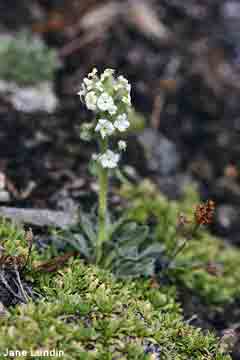
The spreading stickseed, Hackelia patens (Nutt.) I. M. Johnst. (right), is also known as white candle, spreading false-forget-me-not, and by other local common names. The plant may at first glance be taken for an albino form of a blue stickseed. On comparison, however, the leaves are different, the foliage and stems are usually more hairy and the blue-marked white flowers are larger than those of the common small-flowered blue stickseed. Despite the difference in color, this plant's flowers are so similar to those of similar Boraginaceae, that one will easily identify it as a stickseed. The plant's range is restricted to Idaho and to the four states that border on the south and east.
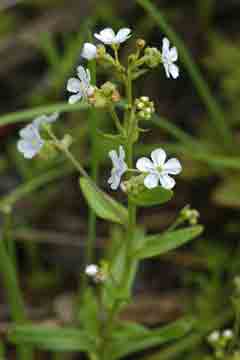
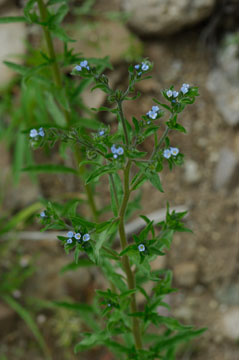
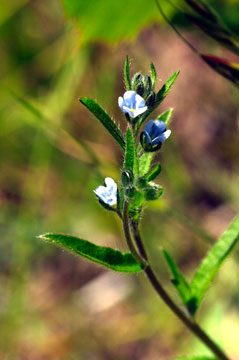

Arctic alpine forget-me-not, Eritrichium nanum (Villars) Schrader (right). This forget-me-not is a striking little alpine plant whose blue blossoms stand out vividly against drab mountain tundra. The plants form matted “cushions” made up of tiny, tightly clustered leaves topped with small, bright blue flowers. This lovely little plant was photographed above treeline in our White Cloud Range. It grows in the Rocky Mountains as far south as New Mexico, in Alaska, and in mountain ranges of Europe and Asia.
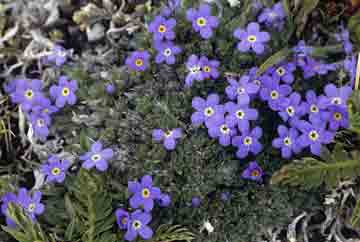
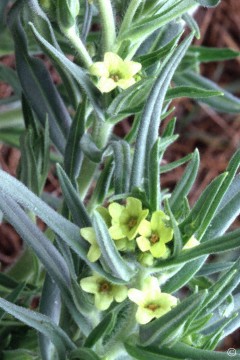
The Common Amsinckia or Fiddleneck, Amsinckia menziesii, (Lehm.) A. Nelson & J. F. Macbr. (right). The common, or small-flowered fiddleneck is a widely distributed native weed that grows to subalpine elevations. As with many Boraginaceae it has bristly stems, leaves, and flower parts. Yellow flowers bloom on an unrolling stem (a “helicoid” or “scorpioid cyme”) explaining the name “fiddleneck.” The plants sometimes grow in such numbers as to turn fields yellow. As they are stiffly bristled, livestock avoid the plants, so they are known as troublesome weeds. German botanist Johann Georg Christian Lehmann (1792–1860), bestowed the generic name Amsinckia to honor William Amsinck, a 19th c. benefactor of the Hamburg Botanical Garden, . Lewis and Clark collected the plant on the Columbia in 1806, although Archibald Menzies, (1754-1842), surgeon and botanist with the Vancouver Expedition (1791-1795), had found it earlier, explaining its species name.
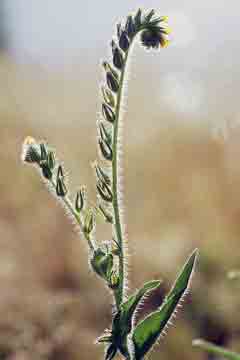
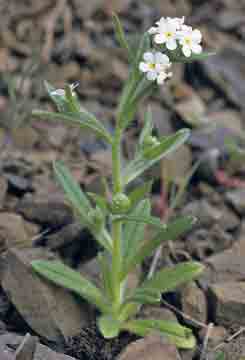
Slender popcorn-flower, Plagiobothrys tenellus (Nutt. ex Hook.) A. Gray (left). Several genera in the borage family are made up of very small plants. This plant’s flowers are only about an eighth of an inch in diameter and the plant may stand no more than three inches high. Meriwether Lewis collected this plant at The Dalles, in present day Oregon, on April 17, 1806. Frederick Pursh overlooked Lewis’s specimen when he classified the expedition’s flora; others found and described it decades later. The name Plagiobothrys, from two Greek words. means “obliquely pitted” referring to the appearance of the plant’s nutlet. The name, tenellus, is Latin for “slender.”
Waterton Lakes cryptantha, Cryptantha sobolifera Payson (right). The genus Cryptantha includes about forty species found west of the Mississippi River of which about fifteen occur in Idaho; most grow at lower elevations. The one shown here (also known as the alpine cryptantha, or alpine cat’s eye) is an alpine plant. Only 1" to 5" high, its leaves and stems are notably bristly. Tiny, clustered, five-petaled white flowers are borne on a relatively long stem that arises from a basal gathering of lanceolate leaves. The plant supposedly is found only in Idaho, Montana, Nevada and mountains of Oregon and California, so one wonders how it came by its common name, since Waterton Lakes National Park is in Canada (contiguous to Glacier National Park). The name, sobolifera, from the Latin, means “sobole-bearing” ( a “sobole” is a shoot, or sucker that grows at the base of a plant). Cryptantha is a taxonomically confusing genus; this plant has had several species names including Cryptantha hypsophila and Cryptantha nubigena (the latter is now relegated to a species found only in California).
